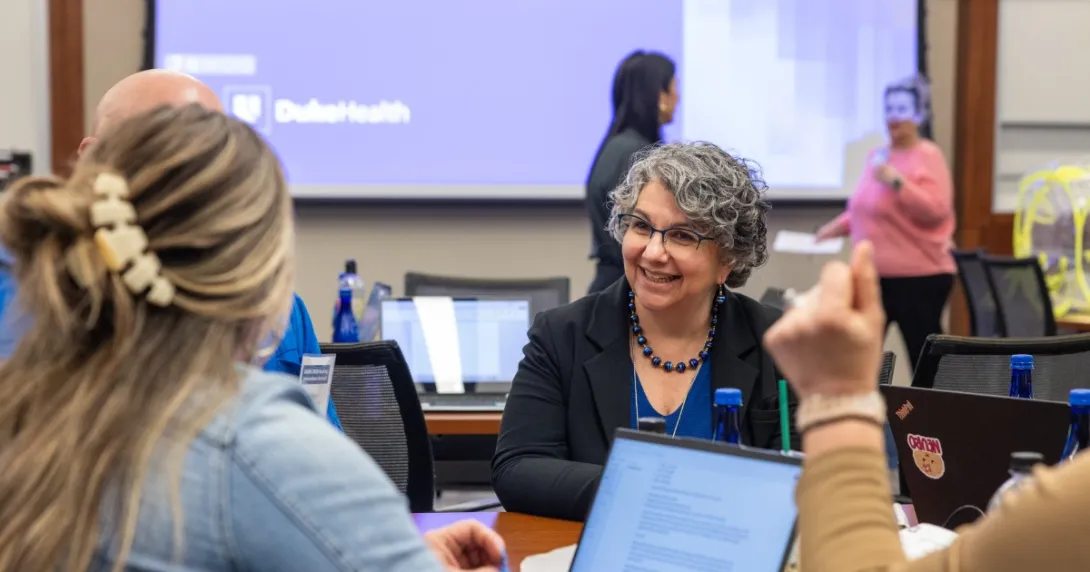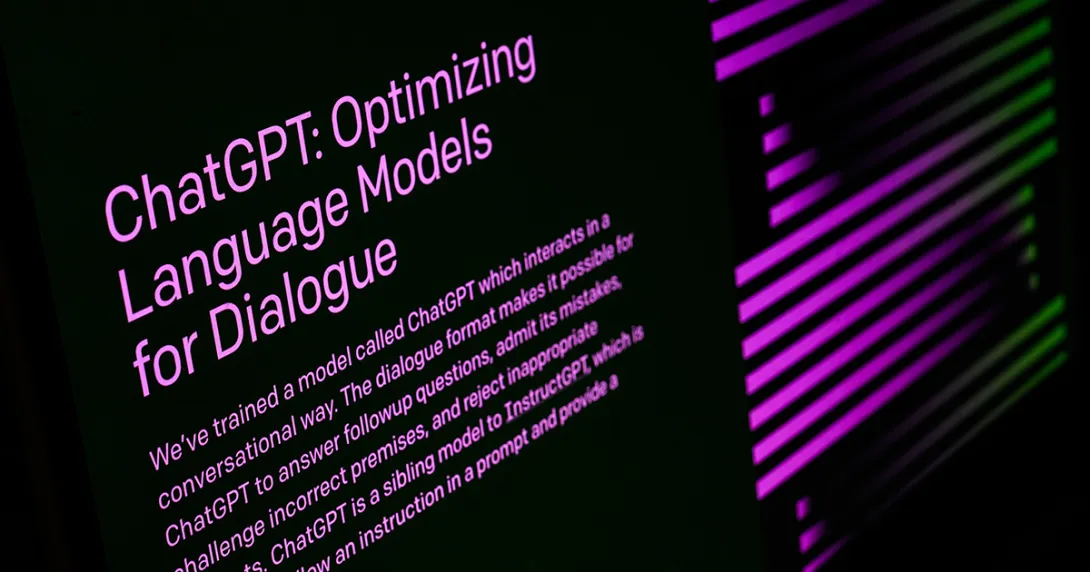
Theresa McDonnell, DNP, RN, chief nurse executive and senior vice president at Duke University Health System and a practicing oncology nurse
Photo: Theresa McDonnell, DNP, RN
Theresa McDonnell, DNP, RN, is chief nurse executive and senior vice president at Duke University Health System, and a practicing oncology nurse. She's among the top nurse practitioner/nurse executives in the country.
No one needs to be told artificial intelligence is the hottest technology in healthcare today. McDonnell is immersed in AI and has many strong opinions – pro and con – about the exploding tech and how it affects nurses. She says on the plus side, AI is reshaping nursing by creating "brain space" for prevention and wellness. And AI and robotics should streamline inpatient care, ultimately freeing nurses for high-impact work.
On the cautionary front, McDonnell says fear-based narratives could exacerbate nurse burnout in an already strained workforce. And that overreliance on tools like triage chatbots risks depersonalizing care and undermining patient trust.
We spoke with this prominent nurse leader to have her expand greatly on her outlook for AI in nursing – both good and bad.
Q. On the positive side of AI in nursing, you say the technology is creating "brain space" for prevention and wellness. Please explain what you mean and talk a bit about the related AI tools that came out of your Nurse Innovation Summit.
A. When I speak about creating "brain space," I'm referring to the ability of technology to lift some of the mental and administrative burdens from nurses so they can focus on higher-order thinking and care. Much of the burnout narrative in nursing stems from constant multitasking, feelings of being overwhelmed, and an inability to pause long enough to process or reset.
By shifting routine, repetitive or time-intensive tasks to well-designed artificial intelligence and digital tools, we give nurses back moments in their day, moments to reflect, to eat, to step away, or to make thoughtful clinical decisions without the pressure of constant crisis management. That pause, however small, can break the cycle of fight-or-flight stress that fuels burnout and compromises well-being.
Resilience and wellness are built on daily experiences that either drain or restore. If a nurse can take a proper break, or if documentation and supply retrieval are made seamless, the physiological stress response diminishes. Over time, this shift lowers the chronic activation of stress hormones and creates space for prevention that benefits both patients and the workforce.
When clinicians are less reactive and more centered, they are better equipped to notice early warning signs in their patients, educate families and advocate for healthier behaviors – all of which support a culture of wellness across the continuum of care.
At our Nurse Innovation Summits, frontline staff have been central in designing and testing systems aimed at exactly this kind of burden relief. For example, we've piloted virtual reality training goggles that prepare nurses for de-escalation when patients are confused or combative, a significant source of workplace stress and injury.
By building those skills in a safe, simulated environment, nurses feel more confident and less anxious in real-world situations. Another example is voice-activated computer vision in supply rooms, allowing staff to quickly locate items without leaving a patient's side or rummaging through shelves. These kinds of practical, nurse-driven innovations may seem small in isolation, but they add up to meaningful reclaimed time and energy.
AI-enabled tools like ambient clinical documentation show similar potential when implemented with care. Involving staff directly in their design and rollout is key to realizing that potential. Engagement in design is what ensures adoption and, ultimately, the creation of genuine "brain space" in practice.
Q. Also on the plus side of AI in nursing, you point to AI and robotics streamlining inpatient care, and other innovations. Please elaborate.
A. One of the most promising uses of AI and robotics in inpatient care is the shift from reactive to proactive intervention. Robotics is already widely used for tasks such as delivering medications, meals or supplies – removing logistical burdens from nursing teams. Soon, we will deploy computer vision technology in patient rooms to provide continuous monitoring.
Instead of waiting for a fall to occur and then responding, these systems can detect patterns of movement and alert staff in real time when a patient is at risk. We anticipate computer vision capturing vital signs, monitoring intake and output, and documenting key patient activities seamlessly. This transition allows nurses to devote more attention to patient interaction and clinical judgment while reducing the risk of harm.
Equally important is the role of AI in strengthening workforce preparedness. Many new nurses entering the field today are clinically competent but may lack extensive experience in conflict resolution or crisis communication. Virtual reality technologies offer a safe and scalable way to fill that gap.
By immersing staff in de-escalation scenarios, guided by AI algorithms that vary the interactions, frontline staff can practice and refine their skills without risk to themselves or their patients. These scenarios enhance safety and build confidence, which is a direct counterweight to burnout.
The real promise here lies in nurse-led innovation. When frontline clinicians identify challenges, whether it's preventing falls, resolving conflict or streamlining care workflows, and partner with technologists to develop systems, adoption is far stronger. These innovations are co-created with frontline staff to reflect the realities of nursing practice.
The success of tools like VR training and AI-assisted monitoring comes from being designed with the end user in mind. This approach delivers both more efficient inpatient care and greater confidence for the workforce.
Q. Now, on the cautionary front, you suggest fear-based narratives could exacerbate burnout in an already strained workforce. Please explain and discuss any thoughts on overcoming this challenge.
A. Change in healthcare always brings with it a level of uncertainty, and when that uncertainty is framed through a lens of fear, it becomes a stress multiplier. For many nurses, the introduction of AI sparks concerns about job loss, reduced autonomy or the erosion of their professional identity.
If left unchecked, those concerns amplify the same anxiety and helplessness that contribute to burnout. In a workforce already stretched by high patient volumes and limited staffing, fear-based narratives risk tipping the balance from resilience to disengagement.
Addressing these concerns requires transparency, inclusion and empowerment. Nurses must be given opportunities to understand what AI tools are, how they work, and what they are and are not designed to do. Knowledge diminishes the unknown and fear.
Even more critical is involving clinicians in the decision-making and implementation process. When staff have a voice in shaping the tools they will use, they are far more likely to see them as supports rather than threats.
We have seen again and again that adoption improves when nurses drive the improvements themselves. Participation in pilot testing, feedback loops and workflow redesign gives staff a sense of agency. That agency reframes AI from something being done to them into something being done with them.
The result is a shift in narrative: rather than "AI is taking my job," the perspective becomes, "AI is helping me care for patients more effectively." Creating that shift is essential if we want technology to relieve the burnout crisis.
Q. Additionally on the cautionary front, you say AI must enhance nursing's human core, and that overreliance on tools like triage chatbots risks depersonalizing care and undermining patient trust. How do hospitals and health systems fight this?
A. At its core, nursing is a relational profession built on trust, empathy and human presence. Any technology that erodes those elements risks undermining the very foundation of patient care. While triage chatbots and similar tools can help manage volume or improve access, they must not replace meaningful human interactions where they matter most.
Overreliance on digital intermediaries can lead patients to feel unseen, unheard or dismissed, which in turn erodes trust in both the provider and the system.
Hospitals and health systems can mitigate this risk through thoughtful integration of AI. That begins with transparency, being clear with patients about when they are interacting with technology and when they are engaging with a clinician. Patients are far more accepting of AI support when it is framed as an enhancement to clinical care rather than a substitute.
Equally important is ensuring clinicians remain at the center of evaluation, diagnosis and treatment. AI can aggregate data, flag anomalies or suggest pathways, but the ultimate decisions must remain human-driven.
The most effective models we are seeing use AI to extend the capacity of nurses and physicians rather than diminish their role. For example, an AI tool might capture and summarize patient histories so a nurse can spend more time on personal connection, education or care planning.
In this way, technology enhances the human functions of care rather than replacing them. By consistently positioning AI as a partner that empowers clinical instincts and strengthens relationships, health systems can safeguard patient trust while still embracing innovation.
Follow Bill's health IT coverage on LinkedIn: Bill Siwicki
Email him: bsiwicki@himss.org
Healthcare IT News is a HIMSS Media publication.
WATCH NOW: How to launch a healthcare AI project, per the VA AI chief


